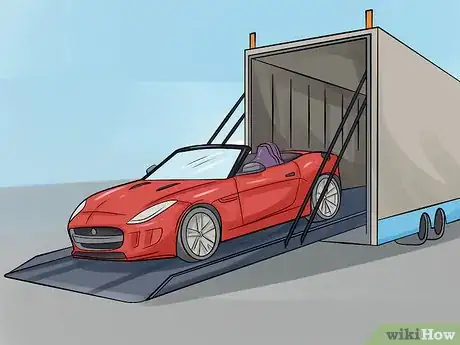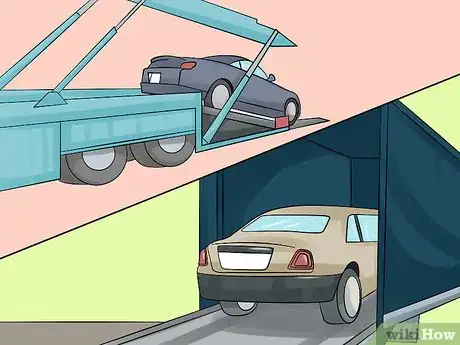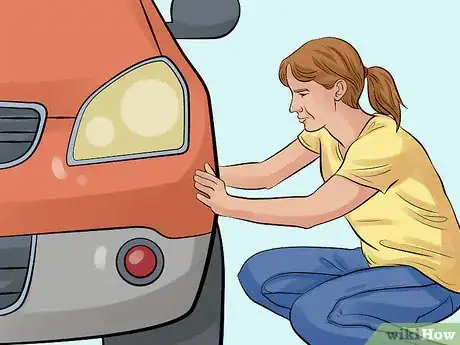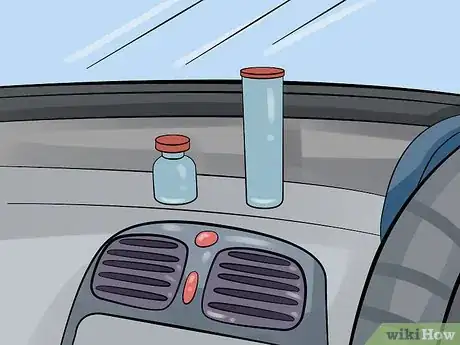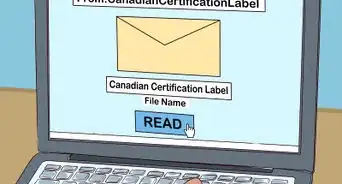This article was co-authored by wikiHow Staff. Our trained team of editors and researchers validate articles for accuracy and comprehensiveness. wikiHow's Content Management Team carefully monitors the work from our editorial staff to ensure that each article is backed by trusted research and meets our high quality standards.
There are 10 references cited in this article, which can be found at the bottom of the page.
This article has been viewed 89,078 times.
Learn more...
Whether you’re moving on short notice or buying a vehicle from someone on the other side of the country, there may be times when it’s impossible or impractical to drive your car to your new destination. In these situations, you can save yourself a lot of time and frustration by having your vehicle shipped. While the process of shipping a car is pretty straightforward, there are still a few finer points worth knowing to help you get the best deal and keep your automobile protected.
Steps
Shipping Your Car
-
1Contact an auto transport service. Businesses that specialize in transporting automobiles over long distances are sometimes called “auto movers.” Check your local listings to find one that operates in your area. By taking advantage of one of these services, you can make sure your car ends up getting where it needs to go without a lot of frustrating coordination or expense.[1]
- Shipping is often the best option for people who are forced to move hundreds of miles overnight, or who would rather avoid an unnecessary road trip.
- Before deciding to do business with a particular auto mover, do a little research to see what level of protection they can guarantee.
-
2List your vehicle’s basic info. When you begin filling out the shipping forms, you’ll be asked to provide details like the make and model, year, mileage and running condition. Based on this information, the auto movers will be able to calculate expenses and recommend the best way for your car to be shipped.[2]
- A compact 4-door sedan in good working order, for example, will be cheaper to transport than a broken-down SUV that won’t start.
- Make sure to record your vehicle’s info as accurately as possible to avoid any disputes or additional fees later on.
Advertisement -
3Choose your preferred transport method. In some cases, you’ll be given a choice of how you’d like your vehicle to be shipped. This may range from a single tow rig to a fully enclosed container. Think carefully about which option best suits your budget and needs before coming to a decision.[3]
- If you’re moving a priceless collection of European sports cars, it will probably benefit you to shell out for a pricier yet more secure shipping option.
- Settle on a shipping date that gives you the most leeway with your schedule.
-
4Take care of the required fees. You’ll typically be asked to pay a certain amount up front, then hand over the rest upon delivery. In addition to the baseline expense of transporting an automobile in your make and model, the distance you’re traveling will be the primary factor in determining how much you owe. Other associated charges may apply, depending on the company you end up going with.[4]
- Altogether, the cost of having your car shipped will likely be somewhere between $500-1,000.[5]
- Inquire about financing options if you’re unable to afford the entire amount at once.
Protecting Your Vehicle in Transit
-
1Get your vehicle insured. A good insurance policy will safeguard your car from any damage incurred during shipping. Although it is extra, the cost of repairs will almost certainly be much higher should something happen to your vehicle. Insurance should therefore be considered a non-negotiable part of the total expense of transporting your vehicle.[6]
- Look over your current auto insurance policy to see if it covers long-distance shipping.[7]
- If you choose not to buy insurance, you’ll be completely responsible for damage and defects.
-
2Pay for a closed container. Assuming you have the option, a fully enclosed transport is a smart way to go if you’re serious about protecting your vehicle. Cars that remain covered throughout the trip are less likely to receive dings and scratches. That means you won’t have to worry about your paint job being ruined between Point A and Point B.[8]
- Be sure to specify your preferred shipping method when filling out your vehicle registration forms.[9]
- On an open carrier, your car will be exposed to the elements, as well as other potential hazards like flying debris.
-
3Inspect your vehicle for signs of damage. Before you part ways with your car, go over it from front-to-back and top-to-bottom and make a note of its general appearance. Do the same as soon as you get it back. If it’s not returned to you in the same condition, the shipping company will be the ones stuck footing the repair bill.[10]
- Don’t forget to list defects like dents, chips and scratches on the paperwork for your vehicle.
-
4Remove all belongings from your vehicle. Clear your car of any tools, equipment, clothing, trash and other items before dropping it off with the movers. Not only will this ensure that nothing gets stolen or misplaced, it may also help bring your transportation fees down a little. In fact, some auto movers make this step mandatory in order to reduce the risk of liability.[11]
Saving on Transport Expenses
-
1Get a quote. Don’t move forward with a shipping contract until you’ve received an accurate estimate. A certain company may seem like a good choice at first, but you may ultimately discover that it’s out of your price range. Taking the time to a evaluate a quote (or a couple) can give you an idea of how much you can expect to pay on average.[14]
- Request a quote on the moving company’s website, or see side-by-side results by comparison shopping on sites like uShip or Auto Transport Direct.[15]
- It’s best to compare companies based on things like their range, insurance coverage and customer satisfaction rather than their rates alone. Remember, you’re paying for peace of mind, as well.[16]
-
2Opt for terminal-to-terminal shipping. Terminal-to-terminal shipping allows you to drop off and pick up your car at different designated sites for a reduced rate. This can be a good way to cut down on out-of-pocket costs if you’ve already been forced to fork over a lot of money on a big move.[17]
- Terminal-to-terminal shipping will put your vehicle back into your hands sooner.
- Make sure you have a way to get to the specified pickup site once you’ve arrived at your destination.[18]
-
3Hire someone to drive your car. As an alternative to shipping, you might also consider paying an independent driver to transport your vehicle personally. Since they’ll be driving your car themselves, you’ll eliminate the added expense of loading the vehicle onto a separate carrier. This is also a helpful option for people looking to transport pets or other valuables that would be difficult to bring on an airplane.[19]
-
4Ship during the offseason. If possible, schedule your move for the beginning or end of the year. Auto movers frequently charge less to transport cars during the winter months, when business tends to drop off. When it comes to getting the best deal possible, every consideration helps.[22]
- Summer is the busiest time of year for most auto transport services.
Community Q&A
-
QuestionWhat is included in auto transport expenses?
 Community AnswerThere's the base rate, which includes factors like your car's size, weight, make and model and running condition. There's also additional fees, which may apply if you own a rare sports car, for instance. On top of that, you're looking at insurance coverage, which you should always be willing to splurge for in order to ensure that your car is returned to you in pristine condition.
Community AnswerThere's the base rate, which includes factors like your car's size, weight, make and model and running condition. There's also additional fees, which may apply if you own a rare sports car, for instance. On top of that, you're looking at insurance coverage, which you should always be willing to splurge for in order to ensure that your car is returned to you in pristine condition. -
QuestionDoes my vehicle have to be fully paid for, registered, and insured to have it shipped to another state?
 Community AnswerNo, but it can't be driven until you register it and get insurance. Obviously, if you move the car you still have to pay for it in full before moving it. Each state may be different though, so check the local laws.
Community AnswerNo, but it can't be driven until you register it and get insurance. Obviously, if you move the car you still have to pay for it in full before moving it. Each state may be different though, so check the local laws. -
QuestionCan I use a car cover to transport a car on an open trailer?
 Casey JacksonCommunity AnswerIt is best if you do not cover the vehicle while in transit on an open carrier. Car covers are made to protect your vehicle from elements such as wind, rain and sun. If you cover your vehicle during transport, the cover will flap during the whole trip, potentially causing more damage to the vehicle than normal open transport would.
Casey JacksonCommunity AnswerIt is best if you do not cover the vehicle while in transit on an open carrier. Car covers are made to protect your vehicle from elements such as wind, rain and sun. If you cover your vehicle during transport, the cover will flap during the whole trip, potentially causing more damage to the vehicle than normal open transport would.
Warnings
- Hold off on signing the delivery notice until you verify that your vehicle has been returned in satisfactory condition. Once you sign your name, you’re on your own.⧼thumbs_response⧽
References
- ↑ https://www.mymovingreviews.com/move/vehicle-transport-new-state
- ↑ http://www.moving.com/tips/moving-and-shipping-your-car/
- ↑ https://blog.allstate.com/how-to-transport-your-car/
- ↑ https://www.angieslist.com/articles/how-much-does-it-cost-ship-car.htm
- ↑ https://www.realtor.com/advice/move/moving-heres-how-to-transport-your-car-across-the-country/
- ↑ http://www.moving.com/tips/7-tips-on-auto-transport-insurance/
- ↑ https://www.realtor.com/advice/move/moving-heres-how-to-transport-your-car-across-the-country/
- ↑ https://www.edmunds.com/car-buying/how-to-ship-a-car-you-bought-online.html
- ↑ https://www.mymovingreviews.com/move/vehicle-transport-new-state
- ↑ https://www.realtor.com/advice/move/moving-heres-how-to-transport-your-car-across-the-country/
- ↑ https://www.mymovingreviews.com/move/vehicle-transport-new-state
- ↑ https://www.angieslist.com/articles/how-much-does-it-cost-ship-car.htm
- ↑ https://www.realtor.com/advice/move/moving-heres-how-to-transport-your-car-across-the-country/
- ↑ https://www.mymovingreviews.com/vehicle-shipping-quotes.php
- ↑ https://www.uship.com/vehicles/
- ↑ https://www.angieslist.com/articles/how-much-does-it-cost-ship-car.htm
- ↑ http://www.moving.com/tips/moving-and-shipping-your-car/
- ↑ https://www.angieslist.com/articles/how-do-i-transport-my-car-during-move.htm
- ↑ https://www.angieslist.com/articles/how-do-i-transport-my-car-during-move.htm
- ↑ http://www.moving.com/tips/moving-and-shipping-your-car/
- ↑ https://www.realtor.com/advice/move/moving-heres-how-to-transport-your-car-across-the-country/
- ↑ https://www.angieslist.com/articles/how-much-does-it-cost-ship-car.htm
